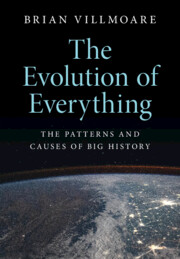Book contents
- The Evolution of Everything
- The Evolution of Everything
- Copyright page
- Contents
- Figure Credits
- Acknowledgments
- Chapter 1: Introduction
- Part I Introduction to the Scientific Perspective on the Past
- Chapter 2: The Origins of the Universe
- Chapter 3: The Structure and History of the Earth
- Chapter 4: Life
- Chapter 5: Evolution
- Chapter 6: Genetics
- Chapter 7: The Evolution of Complex Life
- Chapter 8: The Cambrian Explosion
- Chapter 9: Fish and Land Animals
- Chapter 10: Protohumans
- Chapter 11: The Genus Homo
- Chapter 12: Human Variation
- Chapter 13: Evolution and Human Behavior
- Chapter 14: Brain Evolution
- Chapter 15: Chaos and Complexity
- Part II Science and History
- Additional Readings
- Index
Chapter 10: - Protohumans
from Part I - Introduction to the Scientific Perspective on the Past
Published online by Cambridge University Press: 03 November 2022
- The Evolution of Everything
- The Evolution of Everything
- Copyright page
- Contents
- Figure Credits
- Acknowledgments
- Chapter 1: Introduction
- Part I Introduction to the Scientific Perspective on the Past
- Chapter 2: The Origins of the Universe
- Chapter 3: The Structure and History of the Earth
- Chapter 4: Life
- Chapter 5: Evolution
- Chapter 6: Genetics
- Chapter 7: The Evolution of Complex Life
- Chapter 8: The Cambrian Explosion
- Chapter 9: Fish and Land Animals
- Chapter 10: Protohumans
- Chapter 11: The Genus Homo
- Chapter 12: Human Variation
- Chapter 13: Evolution and Human Behavior
- Chapter 14: Brain Evolution
- Chapter 15: Chaos and Complexity
- Part II Science and History
- Additional Readings
- Index
Summary
This chapter provides a broad overview of primate diversity and evolution, as well as a relatively detailed accounting of early human evolution. It presents a summary of the major anatomical and behavioral differences between apes and humans and the adaptations involved. Humans diverged from the apes between 6 million and 8 million years ago and we have a reasonably good fossil record by 4 million years ago. We can readily track the major adaptive shifts in human evolution, as we became more bipedal and big brained, depending on stone tools by at least 2.5 million years ago. This chapter emphasizes the similarities between apes and humans, and the fact that, evolutionarily, we are apes. Importantly, although there are clear trends through time in hominins, human evolution is not unilineal, and there were as many as seven species and three genera of human existing across Africa at around 2 million years ago, and 27 human species are now known to have existed over the last 7 million years. We were an adaptively diverse group, and the modern idea of a single species of human is a result of a series of extinctions across the hominin order starting around 1 million years ago.
- Type
- Chapter
- Information
- The Evolution of EverythingThe Patterns and Causes of Big History, pp. 131 - 144Publisher: Cambridge University PressPrint publication year: 2022

